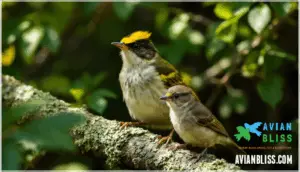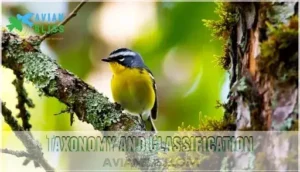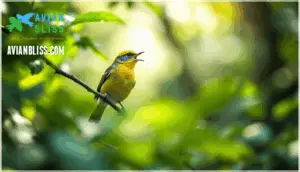This site is supported by our readers. We may earn a commission, at no cost to you, if you purchase through links.

With thirteen recognized subspecies scattered throughout the Americas, this bird has adapted to diverse elevations and forest types while maintaining the core features that define it: gray-green upperparts, bright yellow underparts, and that telltale golden crown.
Whether you’re scanning mixed-species flocks in Central American cloud forests or tracking movement patterns in Brazilian Atlantic forests, understanding this warbler’s identification markers, habitat preferences, and habits will sharpen your ability to spot and appreciate one of the Neotropics’ most widespread yet often overlooked songbirds.
Table Of Contents
- Key Takeaways
- Golden-Crowned Warbler Identification
- Taxonomy and Classification
- Geographic Range and Habitat
- Behavior, Diet, and Vocalizations
- Conservation Status and Reproduction
- Frequently Asked Questions (FAQs)
- What is the size of a golden-crowned warbler?
- Where do golden-crowned kinglets live?
- Do orange-crowned warblers come to feeders?
- What is the difference between a warbler and a tanager?
- Whats the average lifespan?
- Do they migrate?
- Whens the breeding season?
- Any differences between males and females?
- Are they social?
- What predators hunt Golden-crowned Warblers?
- Conclusion
Key Takeaways
- The golden-crowned warbler spans from northeastern Mexico to northern Argentina with thirteen recognized subspecies, each showing distinct plumage variations including yellow, orange-rufous, or even white underparts depending on region, though all share the diagnostic black-bordered crown stripe that makes field identification reliable.
- Despite nesting on the ground—which increases predation risk and limits nest success to just 22–35%—the species maintains stable populations across a 10+ million km² range and holds Least Concern conservation status due to its remarkable habitat adaptability, including persistence in secondary forests and agricultural areas.
- These non-migratory warblers exhibit sophisticated social behavior by joining mixed-species flocks outside breeding season (September–February), which boosts foraging success by 23% through improved predator detection, while breeding pairs defend small territories with rapid vocal responses to intruders.
- Both parents share chick-rearing duties through biparental feeding, with males initially providing 60% of food deliveries and engaging in aggressive mobbing behavior when predators approach within 10 meters, demonstrating significant energetic investment that increases 40% as nestlings mature.
Golden-Crowned Warbler Identification
Spotting a Golden-crowned Warbler in the field requires knowing what to look for, from its compact size to the distinctive head markings that give this bird its name.
The following sections break down the physical traits, plumage details, and age-related differences that’ll help you confidently identify this tropical warbler. Let’s start with the basics: size and measurements.
Physical Size and Measurements
You’ll find the golden-crowned warbler is a delicate songbird, measuring 12.0–13.5 cm (4.7–5.3 in) in overall length and weighing approximately 10 grams. Its wingspan averages 19 cm, while subspecies variation remains minimal across its range. These bird physical characteristics place it alongside similarly sized Tennessee warblers, making comparative metrics useful for field identification. They’re often observed foraging in small loose groups with other species.
Key Physical Measurements:
- Overall length: Adults average 13 cm, with juveniles slightly shorter at 11.8–12.3 cm before their first molt
- Weight proportions: Most individuals range from 9–11 grams depending on breeding cycle and regional food availability
- Wingspan metrics: Wing chord length measures 6.2 cm in males and 6.0 cm in females, with proportionally shorter tails
Plumage and Color Patterns
Once you grasp the warbler’s size, its plumage becomes the real clincher. The golden-crowned warbler sports gray-green upperparts and bright yellow underparts—consistent across both sexes—creating a striking contrast. The head pattern is where things get interesting: a black-bordered yellow crown stripe runs along the center, flanked by a yellow or white supercilium and a bold black eyestripe. Regional plumage varies widely, though. Central American subspecies show vibrant yellows, while southeastern groups (aureocapillus) sport orange-rufous crowns. The southwestern Cabanisi group appears duller overall with gray tones, and Brazil’s hypoleucus subspecies flips the script entirely with white underparts instead of yellow. The bird’s habitat is primarily lowland tropical forests.
| Feature | Adult Coloration | Juvenile Coloration |
|---|---|---|
| Crown Pattern | Black-bordered yellow stripe | Absent or subdued; eyestripe only |
| Upperparts | Gray-green (structural coloration) | Browner, duller tones |
| Underparts | Bright yellow (carotenoid pigments) | Muted yellow or buff |
| Head Markings | Supercilium + eyestripe distinct | Eyestripe present; supercilium faint |
Age differences are subtle but noticeable. Juveniles lack the full crown stripe until their first molt, appearing browner overall. The yellow and golden hues you’re seeing? Those are carotenoid-based pigments from their insect diet, while the gray-green back results from structural coloration—light scattering through melanin rather than pigment alone. Unlike golden-winged or yellow-rumped warblers, this species lacks wing-bars or tail spots, and its ventral yellow coverage is more continuous than Wilson’s warbler. The crown stripe remains your most reliable field mark, offering clarity even when other feathers show wear or seasonal fading.
Key Identification Features
When identifying the golden-crowned warbler, you’ll rely on several diagnostic traits. The head pattern—especially crown identification with its black-bordered yellow stripe—offers the most reliable visual confirmation. Plumage contrast between gray-green upperparts and bright yellow underparts aids quick recognition.
Auditory clues matter too: listen for the species’ distinct "pit-seet-seet-seet" call. Watch for tail flicking and low, ground-level movement through understory vegetation.
Facial contrast—the bold supercilium and eyestripe—clinches warbler identification even in poor light, serving as your go-to bird identification guide.
Differences Between Adults and Juveniles
You’ll notice striking plumage development differences when comparing breeding adult and young birds. Juveniles lack the signature yellow crown stripe bordered in black—retaining only the eyestripe—and show duller, browner tones overall. Molt patterns differ too: adults complete full prebasic molts annually, while juveniles undergo partial preformative molts.
Behavioral disparity is evident as young birds stick to dense understory with reduced vocal activity, showing higher predation rates. These morphological groups occupy similar habitat preferences, though juveniles favor concealment immediately post-fledging.
Taxonomy and Classification
Understanding the Golden-crowned Warbler’s place in the scientific world starts with knowing its formal classification. The species belongs to a well-defined taxonomic structure that includes its scientific name, genus relationships, and notable geographic variations.
Let’s explore the specific details that help scientists organize and identify this distinctive warbler.
Scientific Name and Family
You’ll find this warbler classified under the scientific name Basileuterus culicivorus, a member of the Parulidae family—the New World warblers. The species epithet culicivorus translates to "midge-eating," reflecting its insectivorous lifestyle.
Wilhelm Deppe first described it in 1830 as Sylvia culicivora before taxonomists reclassified it into the genus Basileuterus in 1848. Thirteen recognized subspecies exist, divided into morphological groups across its range.
Genus and Species Details
The genus Basileuterus, meaning "more kingly" from Ancient Greek, emerged in 1848 when Jean Cabanis grouped together distinctive New World warblers. You’ll discover that Basileuterus culicivorus belongs to this genus alongside eleven other recognized avian species, each adapted to tropical and subtropical forests.
- Molecular studies reveal deep genetic lineages across populations, indicating historical isolation events in South America
- The species shows minimal sexual dimorphism, though males display stronger yellow crown coloration during breeding
- DNA analyses confirm gene flow among certain populations while highlighting divergence across low-elevation barriers
- Basileuterus culicivorus shares morphological overlap with closely related species like B. hypoleucus and B. rufifrons
- Phylogenetic reconstructions support this species as part of a South American clade derived from Central American ancestors
Recognized Subspecies and Variations
Fourteen subspecies of Basileuterus culicivorus are recognized by ornithological authorities, grouped into four morphological clusters based on geographic distribution and plumage characteristics.
Genetic divergence below 1% is observed within Central American populations, while mitochondrial DNA variation exceeds 1.5% between northwestern and southeastern groups, revealing substantial differentiation.
Hybridization zones exist where ranges overlap, particularly between cabanisi and auricapillus populations, indicating incomplete speciation with conservation implications for managing distinct evolutionary lineages across this warbler’s extensive range.
Geographic Range and Habitat
The Golden-crowned Warbler’s range stretches from northeastern Mexico down through Central America to northern Argentina, covering an impressive span of the Americas.
You’ll find this adaptable species in diverse habitats, from humid lowland forests to misty cloud forests and even dry woodlands.
Understanding where these warblers live and what environments they prefer helps you know where to look for them and appreciate their ecological flexibility.
Distribution Across The Americas
You’ll find the golden-crowned warbler (Basileuterus culicivorus) across an impressive geographic range stretching from northeastern Mexico down to northern Argentina and Uruguay. This bird’s latitudinal range spans from above 20°N to approximately 35°S, with populations established throughout Central America, eastern Brazil, Paraguay, and Trinidad.
Regional population density peaks in Mexican states like Veracruz and Chiapas, Costa Rica, and southeastern Brazil’s subtropical forests. Fourteen subspecies variation groups reflect distinct geographic distribution patterns, while migratory patterns remain minimal—most populations stay put year-round, though northern birds occasionally drift into southern Texas.
Preferred Habitats and Ecosystems
You’ll encounter this warbler primarily in lowland and foothill forests from sea level to about 2,000 meters elevation, though it adapts well to diverse ecosystems. Its natural habitat centers on moist tropical and subtropical forests with dense forest understory vegetation, including riparian forests along waterways where cover remains continuous.
Despite anthropogenic influences like deforestation, the species shows considerable habitat resilience, persisting in secondary growth and forest edges. This habitat range spans evergreen, semi-deciduous woodlands, and even drier gallery forests—demonstrating the warbler’s surprising flexibility across elevation variation zones.
Range Maps and Regional Presence
When you look at range maps from eBird and ArcGIS, you’ll see this warbler’s impressive geographic distribution spanning from northeastern Mexico to northern Argentina—a continuous breeding presence across tropical lowlands.
Mapping distributions reveals population clusters in Brazil’s Atlantic forests and eastern Paraguay, with elevational limits commonly between 250 and 1,800 meters. Habitat fragmentation is most evident in northern Central America’s dry corridors, where densities appear lower.
Despite localized pressures, the species’ conservation status remains Least Concern, thanks to its extensive range exceeding 10 million km² across the Americas.
Behavior, Diet, and Vocalizations
Understanding the Golden-crowned Warbler’s daily life means watching how it moves, what it eats, and how it communicates.
These birds show distinctive patterns in their foraging strategies, social interactions, and vocal repertoires that help you identify them in the field.
Let’s explore the key behavioral traits that define this species.
Foraging and Feeding Habits
Throughout the day, you’ll find Golden-crowned Warblers actively foraging for food in the forest understory, gleaning insects and spiders from leaves and twigs with striking precision. Their warbler feeding actions include hover-gleaning and sallying to catch prey midair.
Diet shifts seasonally—breeding birds target protein-rich insects like beetles and caterpillars, while non-breeding months bring more fruits and seeds into their feeding habits.
These warblers adapt well to shaded coffee plantations and join mixed-species flocks, though flock dynamics don’t greatly alter their foraging stratum or success rates.
Typical Movements and Social Behavior
Beyond foraging, these warblers show fascinating social patterns. During the breeding season—March through August—pairs defend territories of roughly half a hectare, responding to intruders within seconds.
They don’t migrate south; instead, they exhibit seasonal shifts in elevation and join mixed-species flocks from September to February. Flocking conduct boosts foraging success by 23% through better predator vigilance.
Daily activity peaks early morning and late afternoon, with territorial defense intensifying as pairs patrol their home ranges up to 12 times hourly during peak breeding months.
Songs, Calls, and Communication
These warblers rely on vocalizations to defend territory and coordinate daily life. Males sing rapid, high-pitched trills lasting 1.5 to 2.5 seconds—primarily at dawn—to attract mates and warn rivals. Song dialects vary regionally; Central American populations trill longer than South American birds.
Alarm calls trigger instant silence among neighbors, while soft contact notes maintain flock cohesion. Social context and habitat influence vocal learning, with dense forests favoring lower-frequency songs.
Conservation Status and Reproduction
The Golden-crowned Warbler is doing well across its range, with stable populations and a secure conservation status. Despite this positive outlook, understanding the species’ breeding biology helps us appreciate what underpins its success.
You’ll find details on current conservation concerns, nesting strategies, and how these small birds raise their young.
IUCN Status and Population Trends
You’ll find good news when you look at the Golden-crowned Warbler’s conservation status: it’s classified as Least Concern by the IUCN, a status it’s held since 2005. This reflects the species’ impressive demographic trends, with populations spanning over 10 million km² across Central and South America remaining stable or even growing slightly in recent years.
Here’s what the ornithological research shows about population stability:
- Global numbers reach into the millions, with no significant decline detected across the species’ range
- Survival rates for adults range between 35% and 85%, indicating healthy population dynamics
- Growth rates in Honduras showed positive trends of up to 1.12 individuals per year from 2012–2024
- Habitat correlation studies reveal greater stability in forest-interior populations compared to fragmented areas
- Long-term outlook remains optimistic, with climate shifts showing neutral or slightly positive effects on realized growth
Regional surveys and avian conservation efforts confirm that habitat adaptability—especially the species’ use of secondary forests—buffers populations against deforestation. While localized declines occur in fragmented regions like Brazil’s Atlantic Forest, these don’t impact the overall Bird Conservation Status globally.
Threats and Conservation Efforts
Despite its stable conservation status, the golden-crowned warbler faces significant challenges due to habitat degradation and climate impacts. Invasive species, such as fire ants, reduce nesting success by 15% in affected areas, while agricultural conversion eliminates approximately 1.5 million hectares of forest habitat annually.
Policy initiatives under the Neotropical Migratory Bird Conservation Act have invested over $89 million in avian conservation efforts. These efforts support restoration interventions that have planted 75,000 native trees yearly since 2018.
Nesting Habits and Reproductive Cycle
Throughout the breeding season, you’ll find the golden-crowned warbler constructing unique domed nests on or near the forest floor. The female builds the nest independently in 2–4 days, carefully weaving grasses and plant fibers near protective cover like boulders or shrubs.
The reproductive cycle follows a predictable pattern:
- Nest Site Selection: Concealed locations within 1 meter of rocks or dense vegetation
- Clutch Size: Usually 3 white eggs with rufous spots, laid at 24-hour intervals
- Incubation Period: 10–12 days of female-only incubation with over 50% nest attentiveness
- Fledging Success: Young leave the nest 8–10 days after hatching, though ground nesting increases predation risk
Overall nest success rates range from 22–35%, reflecting the challenges of Bird Nesting Activity in tropical environments where predators frequently threaten Bird Egg Characteristics and survival.
Parental Care and Nest Defense
Both parents share the work of raising chicks through biparental feeding, with males doing 60% of trips early on and females increasing their role after day three. Nest sanitation matters—fecal removal peaks during days 3–7, cutting disease risk and hiding evidence from predators.
When threats approach within 10 meters, adults launch into predator defense with alarm calls and mobbing, showing peak aggression as nestlings mature.
Energetic investment climbs 40% as chicks grow, making these nesting habits a serious commitment.
Frequently Asked Questions (FAQs)
What is the size of a golden-crowned warbler?
Regarding small songbirds, every inch counts. You’ll notice the Golden-crowned Warbler measures approximately 5 inches (7–13 cm) in average length, with a wingspan range near 5 inches (19 cm) and weight variation around 10 grams, making it comparable in size to other diminutive warblers.
Where do golden-crowned kinglets live?
You’ll find golden-crowned warblers—not kinglets across the Americas, from northeastern Mexico through Central America to Argentina and Uruguay.
Regional variations show habitat overlap in tropical lowland forests, subtropical cloud forests, and forest edges. Populations display specific altitudinal range preferences and microhabitat specificity throughout their bird distribution zones.
Do orange-crowned warblers come to feeders?
Though most warblers are insectivorous, focusing on insects and spiders, orange-crowned warblers occasionally visit feeders for suet and peanut butter during winter.
This supplemental feeding provides critical support for winter survival, since they’re among the few warbler species that remain in northern regions during colder months.
What is the difference between a warbler and a tanager?
Warblers and tanagers belong to different bird families with distinct genetic differences and evolutionary history. Warblers (family Parulidae) are small insectivores with thin, pointed bills for catching insects, while tanagers (family Thraupidae) are usually larger, fruit-eating birds with thick, conical bills suited for their diet.
These key differences in avian taxonomy and classification affect their comparative ecology and physical characteristics.
Whats the average lifespan?
Ironically, despite their vibrant appearance, solid data on Goldencrowned Warbler lifespan remains scarce.
Most small songbirds face significant Predation Impact and Disease Effects, living just 2-4 years in the wild, though Habitat Quality and Diet Influence survival rates considerably.
Do they migrate?
No, Golden-crowned Warblers don’t migrate in the traditional sense. These birds are primarily non-migratory, with populations remaining year-round in their territories.
However, some northern populations show seasonal movements and altitudinal migration, shifting between elevations as weather and food availability change throughout the year.
Whens the breeding season?
Like clockwork in nature’s calendar, bird nesting actions follow distinct seasonal patterns. The golden-crowned warbler’s breeding success depends on timing—egg laying usually occurs during spring and early summer.
The incubation period spans 10–12 days, with both parents providing fledgling care through hatching and beyond.
Any differences between males and females?
You won’t notice obvious plumage dimorphism in this species—males and females look virtually identical, with both sporting that distinctive yellow crown stripe and similar olive-yellow tones, making visual sexing in the field nearly impossible without close examination.
Are they social?
You wouldn’t ghost someone mid-conversation, right? These warblers don’t either—they often join mixed species flocks, foraging for food alongside other small birds.
While not forming strong social hierarchy or cooperative breeding systems, they maintain loose pair bonding during breeding season and engage in regular interspecies interactions.
What predators hunt Golden-crowned Warblers?
Snakes, raptors, and small mammals frequently target nests containing eggs or chicks through nest predation.
Adult vulnerability increases during the breeding season when birds defend territories near the forest floor, where habitat impact from fragmentation heightens predator encounters, prompting anti-predator actions like injury-feigning displays.
Conclusion
The golden-crowned warbler’s true value lies in its ordinariness—widespread yet overlooked, it teaches observers that abundance doesn’t diminish significance.
By learning to identify this species across its range, you’re not just adding a bird to your list; you’re improving the skills that reveal an entire warbler guild’s secrets.
Whether tracking mixed flocks at dawn or documenting subspecies variation, your attention to this one yellow-crowned sentinel makes possible understanding how Neotropical forests maintain their remarkable diversity.











